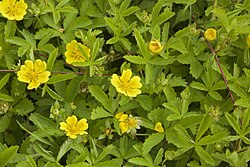Top Qs
Timeline
Chat
Perspective
Potentilla reptans
Species of flowering plant in the rose family Rosaceae From Wikipedia, the free encyclopedia
Remove ads
Potentilla reptans, known as the creeping cinquefoil,[1] European cinquefoil or creeping tormentil, is a flowering plant in the family Rosaceae.[2]
Remove ads
Description
A creeping perennial plant which can reach heights of up to 20 cm.[3] Its trailing stems can root at the nodes,[3] which allows the species to reproduce via vegetative reproduction.[4] The palmate leaves are hairless, attached to long stalks and are divided into 5 to 7 leaflets, with small green leaf-like stipules at the base.[3] The plant blooms between June and September in Europe with flowers that are about 7 mm to 11 mm in diameter with heart-shaped yellow petals. Long stalks support these solitary yellow flowers consisting of 5 petals and sepals with a large number of stamens and carpels at the centre. There are also 5 epicalyx segments, giving the appearance of 10 sepals.[3]
Remove ads
Distribution
Summarize
Perspective
Native Range
Potentilla reptans has a large native distribution across the continents of Europe, Asia, and Africa. In Europe it can be found in the countries of: Albania, Austria, Belarus, Belgium, Bulgaria, Corsica, Czech Republic, Denmark, Finland, France, Germany, Great Britain, Greece, Hungary, Ireland, Italy, the Netherlands, Poland, Portugal, Romania, Slovakia, Spain, Sweden, Switzerland, Turkey and Ukraine.[5] In Asia it can be found in: Afghanistan, China, Cyprus, Mongolia, Iran, Iraq, Kazakhstan, Kirgizstan, Lebanon, Syria, Pakistan, Israel, Palestine, Tajikistan, Turkmenistan and Uzbekistan.[5] In Africa it can be found in the countries of: Algeria, Eritrea, Ethiopia, Libya, Morocco and Tunisia.[5]
Introduced Range
P. reptans has been introduced outside its native range into various countries across the globe.[6] The species has been widely distributed across North America, where it can be found in the states and territories of: Bermuda, California, Colorado, Florida, Georgia, Illinois, Kentucky, Louisiana, Maryland, Massachusetts, Michigan, Minnesota, New Jersey, New York, Ohio, Oregon, Pennsylvania, Virginia, Washington and Wisconsin.[5] It has also been introduced in Canada in the provinces of Ontario, Québec and Nova Scotia.[5] In Oceania the species was also introduced into the countries of Australia and New Zealand.[5]
Remove ads
Habitat and ecology
P. reptans grows in neutral soils, where it utilizes both natural and manmade habitats such as grasslands, hedgerows, roadsides and arable land.[7] The species can also grow in grass lawns and flowerbeds as an unwanted weed.[8] The grizzled skipper butterfly (Pyrgus malvae) utilizes P. reptans as a foodplant for its caterpillars.[9]
Medicinal uses
Alcoholic extracts from roots of P. reptans showed a moderate antimicrobial activity against common wound pathogens.[10]
References
Wikiwand - on
Seamless Wikipedia browsing. On steroids.
Remove ads

